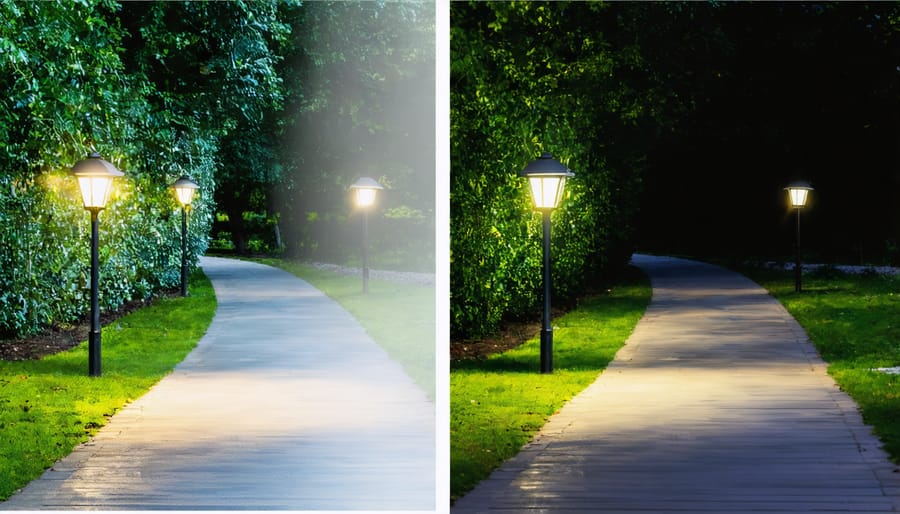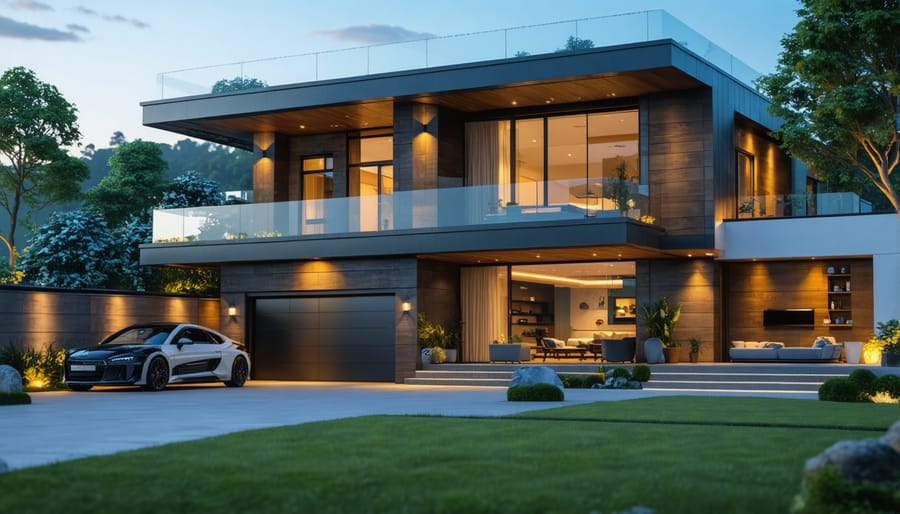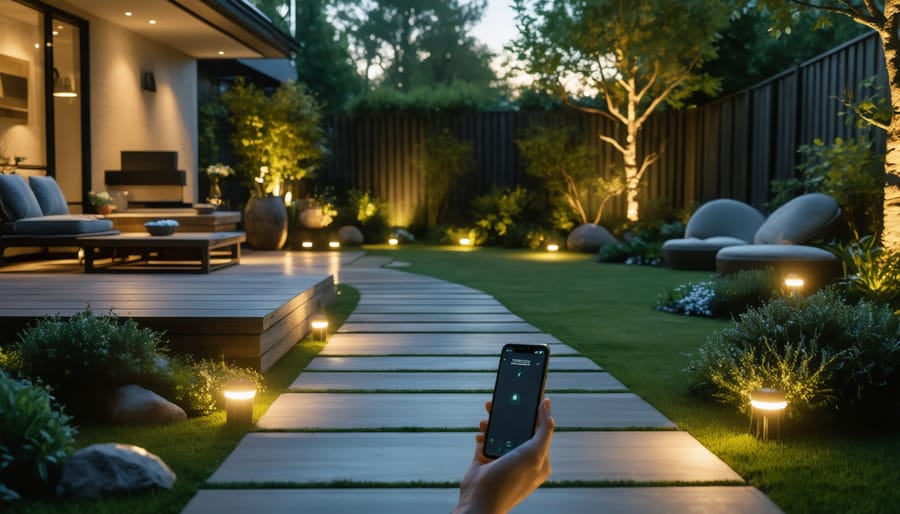Transform your outdoor space into a stunning sanctuary with expert lighting that enhances both security and ambiance. Professional outdoor lighting design balances three critical elements: strategic placement, energy efficiency, and automated control systems. While high-end landscape lighting can cost thousands, savvy homeowners now achieve professional results at a fraction of the price using modern LED technology and smart planning.
Position spotlights at 45-degree angles to eliminate harsh shadows and create depth across your property’s architectural features. Layer different lighting types – path lights, uplighting, and accent fixtures – to create visual interest while maintaining functionality. Modern motion sensors and smartphone-controlled systems reduce energy costs by up to 70% while providing convenience and security.
The key to expert outdoor lighting lies not in the quantity of fixtures, but in their thoughtful placement and integration. Whether illuminating a cozy patio or securing a sprawling yard, proper lighting design transforms outdoor spaces into welcoming extensions of your home while maximizing both beauty and efficiency.
Strategic Placement for Maximum Impact
Key Areas That Need Lighting
When planning your backyard design ideas, proper lighting placement is crucial for both functionality and aesthetics. Start with your home’s entry points, including the front door, garage, and side entrances. These areas need bright, welcoming illumination for safety and convenience.
Pathways and walkways require consistent, gentle lighting to prevent trips and falls while creating an inviting atmosphere. Consider placing lights at regular intervals along both sides of the path, or use downward-facing fixtures to minimize glare.
Security-focused areas like dark corners, property boundaries, and potential hiding spots should be well-lit with motion-sensor fixtures. Pay special attention to areas around windows, detached structures, and dense vegetation.
Don’t forget functional spaces such as outdoor kitchens, dining areas, and patios. These zones benefit from layered lighting that combines task lighting for activities with ambient lighting for atmosphere. Pool areas need appropriate underwater and perimeter lighting for both safety and ambiance.
Remember to illuminate steps and level changes with dedicated fixtures to prevent accidents and enhance visibility during nighttime navigation.

Light Layering Techniques
Creating a well-lit outdoor space is like painting with light, and the key lies in effective layering. Start with ambient lighting as your foundation – this includes mounted fixtures on walls or posts that provide overall illumination. Next, add task lighting in areas where specific activities occur, such as pathways, entrances, or cooking spaces.
Accent lighting serves as your third layer, highlighting architectural features, trees, or garden elements. Position spotlights at the base of interesting features, aiming upward to create dramatic shadows and depth. For additional dimension, consider adding decorative lighting elements like string lights or lanterns in entertainment areas.
Remember to vary the heights of your lighting fixtures. Ground-level path lights, mid-height wall sconces, and overhead pendant lights create visual interest while ensuring comprehensive coverage. When combining different lighting types, maintain consistent color temperatures throughout your design. Warm white lights (2700-3000K) typically create the most inviting atmosphere for residential outdoor spaces.
For the best results, install separate switches or smart controls for each lighting layer, allowing you to adjust the ambiance according to different occasions and times of day.
Energy-Efficient Lighting Options

LED vs. Traditional Solutions
When considering an outdoor space transformation, LED lighting stands out as the clear winner compared to traditional lighting solutions. While the initial investment in LED fixtures might be higher, the long-term savings are substantial. LED bulbs typically use 75% less energy than traditional incandescent bulbs and last up to 25 times longer, significantly reducing both energy bills and replacement costs.
A typical LED outdoor light can last 50,000 hours or more, compared to just 2,000 hours for traditional bulbs. This translates to about 11 years of use if the lights are on for 12 hours daily. The durability of LED lights also makes them ideal for outdoor use, as they’re resistant to temperature changes, moisture, and physical impacts.
Beyond cost savings, LED lights offer superior performance features. They provide instant bright light without warm-up time, work well with motion sensors and timers, and come in various color temperatures to create the perfect ambiance. Many LED fixtures are also dimmable, allowing for flexible lighting schemes that traditional bulbs can’t match.
Maintenance costs are another area where LEDs excel. Their longer lifespan means fewer replacements, particularly beneficial for hard-to-reach outdoor fixtures. Additionally, LEDs generate minimal heat, reducing the risk of fire hazards and making them safer for use near plants and outdoor décor.
Solar-Powered Alternatives
Solar-powered outdoor lighting has revolutionized the way homeowners illuminate their outdoor spaces, offering both environmental benefits and significant cost savings. These energy-efficient alternatives harness the sun’s power during the day to provide reliable illumination throughout the night, eliminating electricity costs entirely.
Modern solar lights come in various styles and configurations to suit different needs. Path lights, wall-mounted fixtures, and decorative string lights are among the most popular options. Today’s solar technology has improved dramatically, providing brighter, longer-lasting illumination compared to earlier models.
The initial investment in solar lighting might be slightly higher than traditional options, but the long-term savings are substantial. With no electricity costs and minimal maintenance requirements, most homeowners recover their investment within 12-18 months. Additionally, many solar lights now feature advanced lithium-ion batteries that last 3-5 years before needing replacement.
When selecting solar lights, consider your local climate and sun exposure. Position solar panels where they’ll receive 6-8 hours of direct sunlight daily for optimal performance. Many modern solar lights include motion sensors and automatic dusk-to-dawn operation, maximizing efficiency while providing security and convenience.
For areas with less sun exposure, hybrid solar lights with backup power options ensure consistent illumination year-round. These smart solutions combine the benefits of solar power with traditional electrical systems, offering reliable lighting even during extended periods of cloudy weather.

Smart Controls and Automation
Motion Sensors and Timers
Adding motion sensors and timers to your outdoor lighting setup is a smart way to maximize both security and energy efficiency. Motion sensors automatically illuminate areas when movement is detected, providing convenience and deterring unwanted visitors. Install these sensors strategically near entry points, walkways, and darker corners of your property for optimal coverage.
Timer controls take automation a step further by allowing you to schedule when lights turn on and off. Many homeowners set their lights to activate at dusk and turn off at dawn, or create custom schedules that match their routines. Modern smart timers even adjust automatically to seasonal changes in daylight hours, ensuring your lights are always operating at optimal times.
For the best results, combine both technologies. Use motion sensors in high-traffic areas and around security-critical zones, while setting timers for ambient lighting features like garden spots or architectural highlights. Many current systems offer user-friendly smartphone controls, allowing you to adjust settings remotely and monitor your lighting system’s energy usage.
When selecting sensors, look for weather-resistant models with adjustable sensitivity settings to prevent false triggers from small animals or moving branches. Remember to position sensors at appropriate heights and angles to ensure reliable operation without creating blind spots.
Smart Integration Options
Today’s smart lighting solutions bring convenience and efficiency to your outdoor spaces without breaking the bank. Many affordable systems connect directly to your home’s WiFi network, allowing you to control your outdoor lights through user-friendly smartphone apps. These apps let you set automated schedules, adjust brightness levels, and even change light colors for special occasions.
Motion sensors are particularly valuable for security and energy savings. When integrated with smart lighting, they can automatically illuminate pathways or entry points when movement is detected, deterring potential intruders while ensuring you never waste energy on unnecessary lighting.
Voice control compatibility with systems like Alexa or Google Home adds another layer of convenience. Simply tell your virtual assistant to “turn on the garden lights” or “dim the patio lights,” and your outdoor space responds instantly. Many systems also offer geofencing capabilities, automatically activating your lights when you return home after dark.
For maximum efficiency, consider smart timers that adjust to seasonal changes in daylight hours. These systems can even monitor local weather patterns, ensuring your lights activate earlier on cloudy days or during storms. The initial investment in smart outdoor lighting typically pays for itself through reduced energy consumption and increased home security.
Maintenance and Longevity
Regular maintenance is key to keeping your outdoor lighting system performing at its best for years to come. Start by establishing a monthly cleaning routine – simply wiping down fixtures with a damp cloth removes dirt, debris, and salt air residue that can corrode components over time. During these checks, inspect wiring connections and ensure all mountings are secure.
Replace bulbs proactively rather than waiting for them to burn out. This prevents potential voltage issues that could stress other components in your system. When replacing bulbs, always match the correct wattage and type specified for your fixtures. LED bulbs typically last much longer than traditional options and require less frequent replacement.
Trim back any vegetation that may be growing too close to your lights, as plants can trap moisture against fixtures and create potential hazards. Before winter, check that drainage holes in ground-mounted fixtures aren’t blocked with debris, and consider using protective covers for more exposed fixtures during severe weather.
For low-voltage systems, inspect the transformer annually and listen for any unusual humming sounds that might indicate problems. Keep a maintenance log to track when you’ve performed checks and replacements – this helps establish patterns and anticipate when components might need attention.
During spring, test motion sensors and timers to ensure they’re still working efficiently, and adjust settings as needed to accommodate changing daylight hours. These simple maintenance steps can extend your lighting system’s lifespan by several years while maintaining optimal performance.
Transforming your outdoor space with expert lighting doesn’t have to break the bank. By implementing strategic placement, choosing energy-efficient LED fixtures, and incorporating smart controls, you can create a beautiful and functional lighting system that saves money in the long run. Remember to focus on essential areas first, like pathways and entryways, before expanding to accent lighting for landscaping and architectural features. Take advantage of solar options where possible, and consider installing motion sensors for added security and efficiency. With proper planning and the right choices, you can achieve professional-looking results while maintaining control over your budget. Start small, expand gradually, and enjoy the enhanced beauty, safety, and value that well-designed outdoor lighting brings to your home.





Leave a Reply